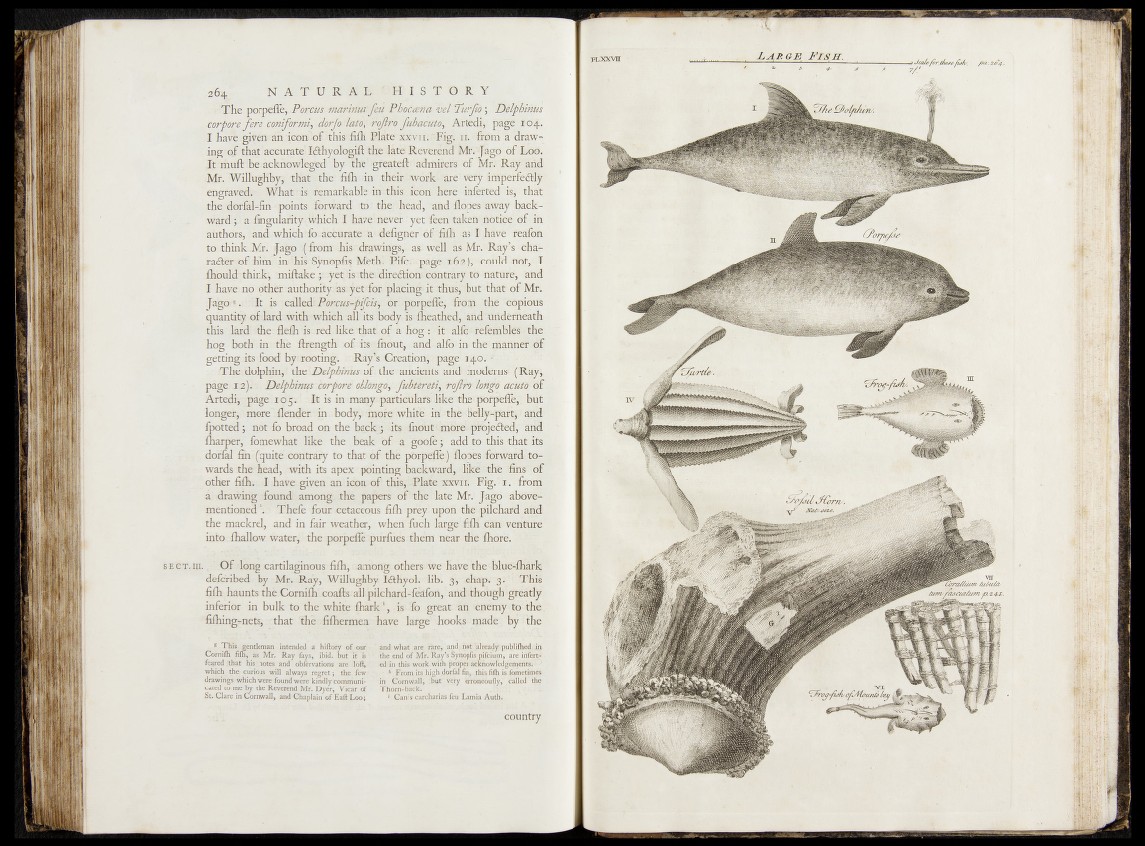
2Ó'4 N A T U R A L l ï I S T O R Y
-’Mffihé porpeflèj-PörcftfJ mdniiïtes?'feu-Phoc&na>vel Turftd; Delphinus
corpore fere coniformi, dorjolato., rojlro fubacuto, Artedi,' page 1Ó4.
I have given an icoalof this fifh Plate 3è3^vii. ~<Figl 11-.«from a drawing’
q£ that accurate’ Iöhyologiff the iat& Revferend'Mr.-<Jago of :L'oë.
It muft ibe-ackhowleged by the! gfeateft ' admbers of Mr. Ray énd
Mr.Willughby, that the fifh *in their «work-- ^are' very irriperfedt-ly
engravècfe Whatvis fematkable in-this icoiï here inferted is* that
the dorfal-fin - points forward tó the; head, and Hopes away backward
; a Angularity, which I ha-venever ' yet feen taken notice of-in
r r&hthors, and which’fo-achtmtfoi&'defigner <^^p.;xas-
to think Mr. iago ’(from «his drawings, as* well as Mr.; Ray’s -cha-
radtervof Mm in this: Synopfi^ MëtM Rife: ^page i 6i2^lpQÜtó ;h^J:,i‘i
fhould think, miflake 4^yet:ïis:the; direöioiaicöntrary to nature, and
I have no other authority; as'yet-for- plaeingdt thtisf but that of Mr.
Jago/f.i It is -~cdftediPorcus>jpifciSi drl porpefiè, -ffófn thé -;©§piói5§
quantity of lard with which all itsr body is fheathed, and Underneath
this' lard' the; flefh is:red like that- of a- fróg';Wts alfo^fefemblé’s the
hog bothin>:tHe lhength xif its^fhout, and~alföumthe mannér of
getting its food: by flooring. Ray’s Crearion$~pagei40. ?
The dolphin,; the Delphinus of; the ancients arid-moderns* (Ray;
- page 12).;. Delphinus corpore oblongo, fubtereti^ rojlro long'd dcufo 'oi
Artedi, page 105. It is in many particulars like thè*pöfpefie,'j but
longer, more dender in - body,* more white in: \the beiy-part, f and
Ipotted; not lb broad on the
lharper, lqmewhat like the beak óf a goofe; add to this that its
dorM fib (quite contrary to that óf the pbrpefic) dopes forward towards
the head, with its apex pointing backward, likesehe 'fihs 'óf'
other fid». I have given an icon o f this, «Plate xxviri Fig. 1. from
a drawing found among, .the papers oFthe late Mr. Jago above-
mentioned \ Thefe four\eetaceous fifh prey-upon the pilchatd afid
the mackrel, and in fair weather, when luch large fifK can venture
into:lhailow watery the porpefle purities them near the Shore. i f
s e c t . in.. O f long cartilaginous fifh, .among others We have the blue-lhark
delcribed by Mr. Ray, Willughby Iéfhyol. lib; This
fifh haunts the Cornifh coafts.all pilchard-feafori, and though greatly
inferior in bulk to the white fharkl, is fo great an enemy to the
fiihing-nets, 'that the .fifhermen have large hooks made by the
g This. gentleman intended a hiftory of our
Cornifh fifh, as Mr. Ray fays, ibid, put it is
feared /that his. notes and obférvations are loft,
whichthe curious will always regret; the few
drawings which were found were kindly communicated
to me by the Reverend Mr. Dyer, Vicar of
St. Clare in Cornwall, and Chaplain of Eaft Loo;
and what are rare, apd; hot already publifhed. in
the end of Mr. Ray’s Synopfis pifcium, are ihfertf
ed in this work with proper acknowledgements* 3
I 1 I From its high .dorfal fin,,,th^ fifh is fometimes
in Cornwall; tbuf'V'eiy effoneoufiy, called the
Thom-back.
1 Canis carcharias feu Lamia Auth.
country